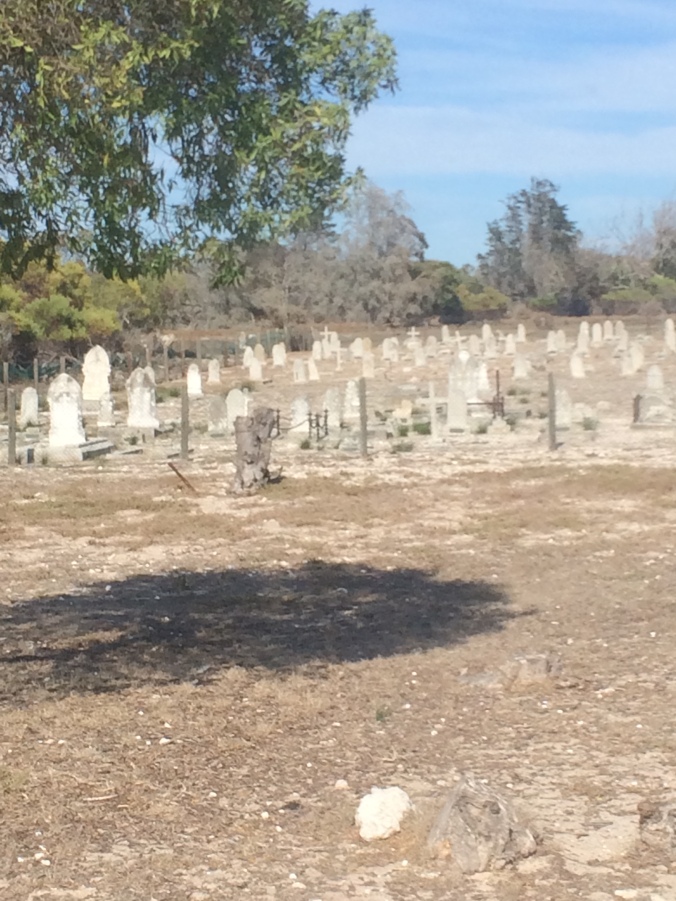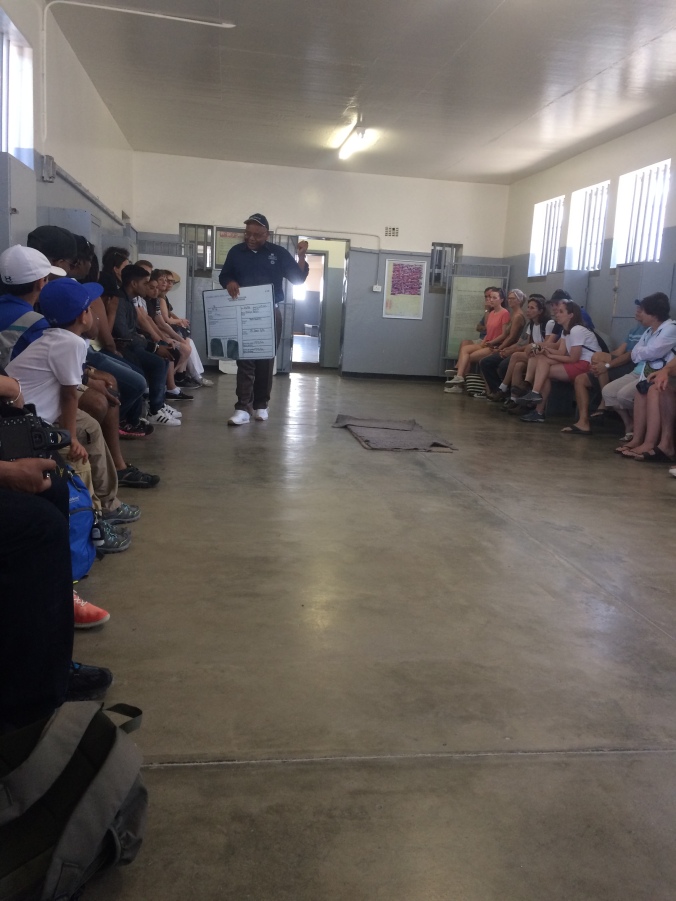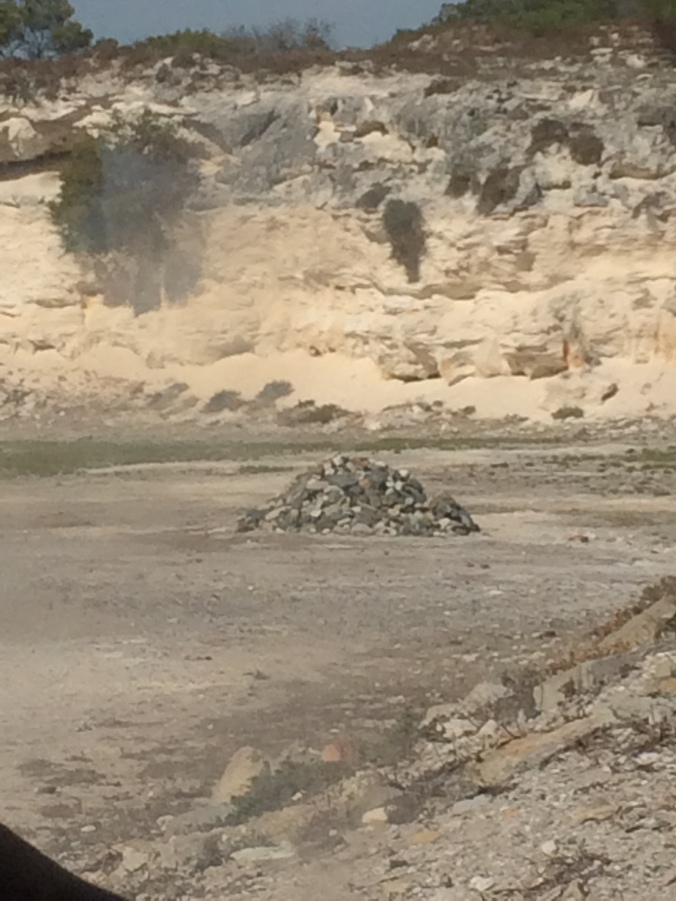If you are interested in the remarkable political history of South Africa, a trip to this symbol of the struggles of those imprisoned here at Robben Island will probably give you the most explicit insight into this. It was truly an eye-opener.
Although Robben Island is most famous as a prison for anti-South African government (anti-apartheid) political rebels, beginning in 1961, it has a history of use by the Dutch and British too. It has served variously as a dumping ground for criminals, political prisoners, holy men, prostitutes, lunatics, lepers and the chronically ill. There still exist some monuments on the island from pre-afrikaaner use times.
Getting on to the island is via Murray’s Bay Harbour, named after Scottish whaler John Murray who opened a whaling station on the island:


Some of the pre-apartheid monuments on the island include a leper graveyard and a light house. Lepers were exiled to the island from 1845 onwards and those who died were buried in the graveyard. The lighthouse was completed in 1865 on Minto Hill to inform ships approaching the island:



During World War 2, the island was fortified with 9.2 inch and 6 inch guns as part of defending Cape Town:

From 1961, the island was taken over by the Prisons Department of South Africa. Prisoners arriving at the island were greeted by a slogan on the gate (still there today) that read: “Welcome to Robben Island: We serve with Pride.” By 1963 it had become a Maximum Security Prison (MSP):


In 1969 the Kramat, a muslim shrine to the west of the MSP, was built in honour of Sheikh Syed Moturu or the Prince of Madura who died on the Island in 1754. Moturu, who was one of Cape Town’s first imams, was exiled to the island in the mid-1740s. Muslim political prisoners would pay homage at the shrine before leaving the island:

We were given a detailed tour of the interiors of the MSF, with its various sections, by an ex-political prisoner of the island, Ntando Mbatha (The guy holding the placard below). (You can hear his personal story on this page: http://www.robben-island.org.za/stories.) The beds and room shown are from Section F, a communal cell which was apparently horrifically crowded and housed 60-70 prisoners in cramped freezing conditions:


Even the prisoners diets were segregated according to their race, with black prisoners having the worst diet:

Shown is an example of censoring prisoners post in the Censors office. Prisoners were only allowed to send and receive one letter every six months. Post to and from prisoners was checked carefully and any political information that was deemed damaging was blanked out:

Section B of the MSF was one of the isolation blocks. This section housed many influential political figures, including Mandela. The fourth window from the left is Mandela’s cell, and also shown is the interior of his cell, measuring only about 2 meters by 2 meters, where he was kept in solitary confinement for 16 hours a day. The bucket was used as a toilet:


Some more pictures from Section B:
Another of the prisoners in Section B alongside Mandela was Billy Nair, who talks of the freezing cold conditions that were part of their daily living. All prisoners had to carry around a prison identity card with their prisoner number on. Our guide emphasised that wardens would use your prisoner number only when referring to you, to reduce you from a person to just a number



The last political prisoners were released from Robben Island in 1991. This Cairn of stones shown below, called Isisivane at the entrance to the Limestone quarry was created by ex-political prisoners, led by Mandela during their reunion on the Island in 1995. Mandela and the prisoners worked long hours in this quarry, quarrying lime, ruining their eyes from the relentless glare. They were not afforded protective body items or clothing. Mandela and his fellow prisoners used their time in the quarry to educate themselves in everything from literature, philosophy, history and current events. The monument of the pile of stones represents the people of different colour, gender and ethnic backgrounds who united against the oppressive regime of apartheid

In 1997 control of the island was passed to the Department of Arts and Culture, which established it as a museum and a World Heritage site. To date three of the former inmates of Robben Island have gone on to become President of South Africa: Nelson Mandela, Kgalema Motlanthe and (regrettably, as most will agree) the current President Jacob Zuma.
Finally, this post doesn’t do justice to so much more depth and significance that this place has. You have to visit it yourself to get a glimpse into it’s not so distant history of oppression overcome by the human spirit
(P.S I know the photographs aren’t all very clear, the tour was quite jam packed and I was rushing to follow it and also try to capture it all with my iphone camera!)
As usual I look forward to any comments etc


Fantastic read – thankyou. It still amazes & shocks me that humans can b so cruel to each other.
Yes I get that if u are a criminal u hav to b punished BUT often there is an inbalance of justice & it crushes my soul.
I can only b thankful I did not live in a time or place where the colour of my skin dictated how I wud b treated – which was usually horrific & beyond.
I wish we cud all live on this planet without war, racism & abhorrent crimes.. but crazed lunatics have other plans. The colour of ones skin should not determine how quickly u r promoted thru the ranks or treated much much better; u shud b judged on your talents & hard work.
Maybe one day the world will be a fairer place – it is getting better BUT my goodness its taking a long time!
The stunning sunshine makes the pics more palatable & softens the harshness of what happened here – I hav many books on these topics & used the theme ‘Freedom’ as the inspiration for a textile project.. I researched lots of humbling & haunting stories – stories that stay with you forever 😦
Lets enjoy what life we have; lets help our decent neighbours; b the best u can & b honest – it will help to balance out the cruelty & maddness that seems to b abundant all over..
Smile every day & b the best u can in yoursel & b kind to other’s.
If I see any cruelty or crime- I am reporting it!
& when I do come over – I wud like to visit Robby Island 😀 mayb even stay a night in a cell..
Lets see!
Catch up soon Miss Reporter person & look forward to ya nxt review 🙂
♡Much lov ♡
XtutsX
LikeLiked by 1 person
Wow. Aeysha.
Such lovely scenic views.
And such a rich history.
I really enjoyed reading about all the history surrounding the area.
It truly looks like a fantastic place, and its great that you are both getting to see the sights.. TOGETHER.
Enjoy.
Xx
Zainy Mamu.
LikeLike